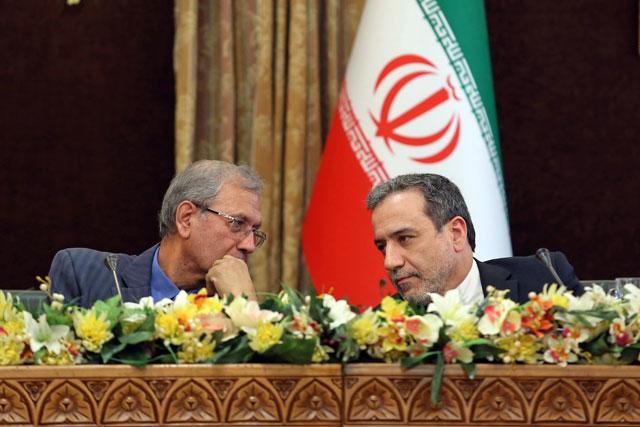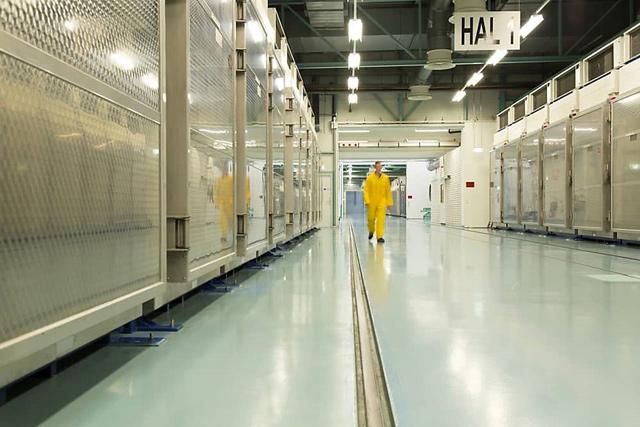You are here
Hard-won 2015 Iran nuclear deal
By AFP - Jul 08,2019 - Last updated at Jul 08,2019

This handout photo provided by the Iranian presidency shows Iran's government spokesman Ali Rabiei (left) and Deputy Foreign Minister Abbas Araghchi speaking to each other during a joint press conference at the presidential headquarters in the capital Tehran on Sunday (AFP photo)
TEHRAN — Iran agreed with major world powers in 2015 to freeze its nuclear programme in return for the lifting of punishing international sanctions.
But in 2018, President Donald Trump pulled the United States out of the agreement, later reimposing sanctions.
Iran on July 1 announced it had exceeded its enriched uranium stockpile limit set by the deal, and on Sunday said it was set to breach a cap on the agreed maximum purification level.
Here is a look back.
Long road
Tough negotiations start in June 2013 between Iran and the five permanent members of the UN Security Council — Britain, China, France, Russia and the United States — plus Germany.
The final deal is reached on July 14, 2015, bringing an end to a 12-year international row over the Iranian nuclear issue.
The aim
The goal of the deal is to render it practically impossible for Iran to build an atomic bomb, while at the same time allowing it to pursue a civil nuclear programme.
As part of the agreement, Tehran pledges to reduce its nuclear capacities for several years.
The accord caps Iran's enrichment maximum at 3.67 per cent, sufficient for power generation but far below the more than 90 per cent level required for a nuclear weapon.
Iran agrees to slash the number of centrifuges — which are used to enrich uranium for nuclear fuel but can also be used in the production of an atomic bomb — from more than 19,000 to 5,060, and to maintain that level for a decade.
It also agrees to modify its heavy water reactor in Arak to make it impossible to produce plutonium for military use.
The deal comes into effect on January 16, 2016.
Inspectors, sanctions relief
The International Atomic Energy Agency is charged with regular inspections of facilities such as uranium mines and centrifuge workshops for up to 25 years.
The accord also paves the way for a partial lifting of international sanctions on Iran, opening the door to foreign investors. French energy giant Total and carmakers PSA and Renault all strike deals.
UN embargoes on the sale of conventional arms and on ballistic missiles to Iran are however maintained up to 2020 and 2023 respectively.
US exit
But on May 8, 2018, Trump announces the US is pulling out of the agreement and will reimpose sanctions on Iran as well as all companies with ties to the Islamic republic.
On August 7, it imposes sanctions that target access to US banknotes and key industries such as cars and carpets. They had been in place prior to the nuclear deal.
A second tranche of sanctions kicks in on November 5 targeting Iran's vital oil sector and central bank transactions.
From May 2, 2019, Washington ends temporary sanctions waivers it had granted to the eight main purchasers of Iranian oil, raising the pressure on holdouts China, India and Turkey to find other suppliers.
Deal unravels
Responding to the sanctions, Iran on May 8 announces it will stop observing restrictions on its stocks of enriched uranium and heavy water agreed under the deal.
It also gives Europe, China and Russia until July 7 to help it circumvent US sanctions and sell oil, saying it would otherwise abandon more of the terms.
Hours later Trump announces new measures on iron, steel, aluminium and copper.
On June 24, the US imposes financial sanctions on Iran's supreme leader Ayatollah Ali Khamenei and senior Iranian military leaders.
It comes as tensions rise after Iran's downing of a US drone over sensitive Gulf waters and a series of tanker attacks that Washington blames on Tehran, which has denied involvement.
On July 1, Iran says it has exceeded the limit on its enriched uranium reserves set by the deal.
On July 7, Iran announces it is set to breach the cap on its enriched uranium purity within “a few hours” and threatens to abandon more nuclear commitments in “60 days”.
Related Articles
TEHRAN — Iran resumed uranium enrichment at its Fordow plant on Thursday, in the fourth step back from its commitments under the landma
TEHRAN — Iran agreed with major world powers in 2015 to restrict its nuclear programme in return for the lifting of punishing international
DUBAI — Iran is taking preliminary steps to design uranium fuel with a purity of 20 per cent for reactors instead of having to cop














